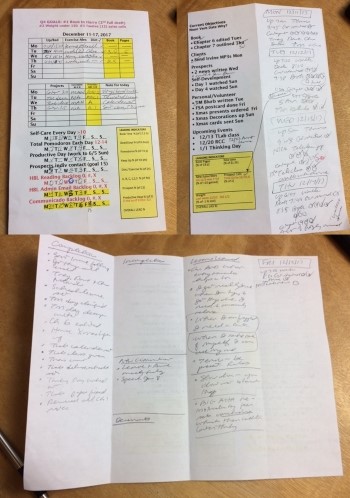In the Thinking Lab, I offer a self-study course called, “Evolving a Scheduling Infrastructure.”1 The goal of the course is to help you get a basic system in place to keep you productive. The basic system consists of only three things:
1. A daily planning session (15 minutes per day)
2. A weekly planning session (20-30 minutes once per week)
3. A way to keep track of time
Implicit in the system is a fourth element:
4. A set of benchmarks and other metrics for measuring success
The reason to develop a system is to help you automatize new policies and practices for your own productivity. You can’t change habits with just an intention. You need a system in place to remind you of your goals, values, and intentions, to help you track progress, and to help you troubleshoot problems.
In the course, I give an example of a daily planning sheet that I use to implement my system in a very simple, efficient way. My daily planning sheet is just a piece of paper that I print each week. It has designated areas to track goals, benchmarks, and work. Here’s what the two sides of this week’s sheet looks like today (Friday morning):

Most of the time, my planning sheet is folded up, so that I am just looking at the goals and today’s tracking notes. There is also a little piece of paper with my self-care list, which is normally slipped inside the fold. Here’s what it looks like today:
![]()
I’m not expecting you to read my sheet. Actually, I’d rather you didn’t, since one of the goals I’m tracking is my weight. 🙂 I’m sharing my sheet, because a Thinking Lab member asked me to talk more about how my particular sheet evolved, so that he could figure out what to put on his.
So, you need to understand that my complex sheet evolved gradually over 15 years, starting when I read David Allen’s Getting Things Done in 20022 and first attempted to develop a productivity system.
My top takeaway from my 15 years of experimentation is twofold: the system has to be dead easy to use, and you need to be convinced that every second you spend using it pays off. That’s why I recommend starting with a very simple system (just listing goals and tracking time).
My sheet is jam packed with items, but each little bit came online at a different time. Looking it over, there is way too much to discuss in detail, so I’ll just explain the 7 functional areas:
1. Page One Benchmarks: I track all kinds of productivity items like how much time I worked on my book and how many emails were left in my inbox at the end of the day. I fill out the benchmarks every day as part of my daily 15 minutes of planning.
These are all on the front page (top left in the first picture). 15 years ago I kept track of only 4-8 items, which I would write in at the bottom of my weekly calendar. The current list reflects my current projects and priorities.
Most people, when they think about being productive, have a list of things they’d like to do daily or most days. Tracking the most important ones as benchmarks helps you do them more consistently.
Two pieces of advice: First, it’s important to limit the number of things you track. I’m maxed out. In fact, I use this paper to stop me from adding items. I have to take something off if I put something on. If in doubt, track less.
Second, notice your reactions to the items you track. If you feel bored or indifferent to them, why are you tracking this item? If you feel guilty about not doing something, that’s a warning bell to rethink how it relates to your priorities. I adjust my benchmarks incrementally during the year as I shift goals, automatize habits, or take on new campaigns for self-improvement.
2. Little bitty sheet of self-care: This is the extra sheet that shows up in the 2nd picture with today’s sheet open to tracking the day. Maybe 5 years ago, I decided I needed one number to include information on a lot of topics that added up to whether I have a good day or not. The little piece of paper has 15 items on it — everything from playing my flute to exercising to staying on top of admin fits in here — and each day I just go through and check off which ones I did the previous day. I record the number on the front page with other benchmarks.
This list changes every year or so. Usually I upgrade the items. When “house made nice” became easy, I upgraded that item to be “house and office made nice.” Sometimes I take something off the list, because I don’t need to track it. For example, I used to track whether I got 7 hours of sleep a night, but I always stay in bed for 7 hours these days. Exceptions are so rare that it’s not an issue I need to track anymore.
I tote up my self-care number every day as part of my daily planning. I’ve observed that whenever I’ve had a “good” day, I score 10 points or more. These day I try to score 10 — sometimes doing a couple of more things on my list to help turn a mediocre day into a good one.
3. Page One & Two Lead/Lag Indicators: There are two yellow boxes with “leading indicators” and “lagging indicators.” I have been developing this section in the last two years based on what I learned3 from the book The Twelve Week Year.
This is an advanced technique involving weekly benchmarks tied to my quarterly goals (which you might notice at the top of the front page). I calculate my indicators at the end of the week during my weekly planning session, which is why these boxes are all empty. In the end, I get an overall percentage success for activities under my control, and a percentage of results achieved.
This is an example of having read about an interesting productivity technique, and then having taken steps to implement it into my life. When I read the book, I didn’t change everything I was doing. But I did modify my sheet to try out this particular technique. This particular area of the sheet is still a work in progress for me. I’m still figuring out the right lead and lag indicators.
4. Page Two Weekly Goals: On the second page (top right), I list my goals for the week, so I can look at them every day. I fill this out as part of my weekly planning session. As you can see from the picture, I check off items and I add items during the week.
Long ago, I just had lists of big goals and projects, and plans for the day. I didn’t set goals for the week. But about 10 years ago I wanted to see more progress, so I started specifically listing goals for the week. About 5 years ago I started using the Noun Verb Date format, which I got from my coach, David Newman.
In setting goals for the week, I take advantage of the small amount of space. If I can’t fit the week’s goals into the space available, I know that I have too many goals for the week.
5. Inside: Completions & Incompletions: On the inside of the sheet, I use the folds to divide the paper into four columns. The first column is devoted to recording completions at the end of each day. Reviewing what you’ve accomplished is a good way to keep focused on positives.
The top of the second column is for recording incompletions at the end of the week. An incompletion is anything that I had intended to get done but didn’t complete by the end of the week. Recording incompletions is important: it helps you confront the undone, and accept it as a fact needing consideration.
I got the idea of recording completions and incompletions from a book called Attracting Perfect Customers, which I read about 9 years ago4. The book also recommended that you date and sign your list — which is something I have done regularly ever since.
Going back, the earliest daily planning sheet I can find quickly is from the week of September 19-25, 2009, and on the inside is the list of completions and incompletions, signed by me.

(I notice it has only 4 daily benchmarks — a good place to start!)
This is an example of a practice that has stayed unchanged since I adopted it all those years ago. The ritual of listing completions and incompletions, and then signing off on the week, helps me to celebrate victories and mourn failures, and then start with a fresh slate for the new week.
6. Lessons Learned: The third column on the inside is “Lessons Learned.” I am always thinking about my experiences and reaching new conclusions. Once a day I add one-sentence “lessons learned” to the third column of the sheet. Writing down lessons learned helps me remember them and commit to action on them.
This is an example of an innovation — something I added to my process to solve a problem. I got frustrated with having great insights and then forgetting them. It seemed like I had to relearn lessons that I had learned. So, to help myself remember them, I started writing them down.
When I first decided to do this, I wrote detailed comments every day in a weekly engagement calendar. I did this religiously for a year, and then concluded it was just too much work to keep up. So I simplified it. I added a column to my daily planning sheet for capturing just top lessons learned.
7. Time tracking: The rightmost column of both sides of the paper are for time tracking. I use the Pomodoro Technique, a fairly simple way to keep track of time on tasks. Each 25-minute increment of concentrated time is one Pomodoro. I’ve been using the Pomodoro Technique since late 2009, when my friend, Rohit Gupta, sent me a link to it and asked me what I thought of it5. I tried it out and thought it was terrific.
If you look closely, you can see that on the September, 2009 daily planning sheet I had been making “to do” lists for the day and checking off boxes. When I read about the Pomodoro Technique, just a month or after this, I reallocated that space on my sheet for keeping track of Pomodoros, as you see on today’s sheet.
* * *
The moral of this story is not to go make yourself a complicated daily planning sheet with dozens of things to track. The moral is: find your own simple way to keep track of your work and self-improvement goals, in a way that makes sense to you and doesn’t take a lot of time. As you learn new methods, you can add to it. Start simple, grow into complexity.
The purpose of a sheet like this is to support you as you change habits, learn new processes, and grow your skills. I love my little sheet, because it helps me keep my values and goals top of mind every day, it helps me see what I can do each day to move forward in my life, and it helps me see clearly where I might want to make changes. I hope my story inspires you to develop a sheet or a system that works for you as well as this one works for me.
* * *
Here are links to the resources mentioned in the article:
- “Evolving a Scheduling Infrastructure” is a class available in the Thinking Lab.
- Getting Things Done was recommended by me here.
- The Twelve Week Year was discussed by me here.
- Attracting Perfect Customers is by Stacey Hall and Jan Brogniez. Note: I found the exercises in this book to be very valuable, but I disagree with the theory.
- The Pomodoro Technique by Francesco Cirillo was recommended by me here.









0 Comments